Living room zoning: design methods and ideas
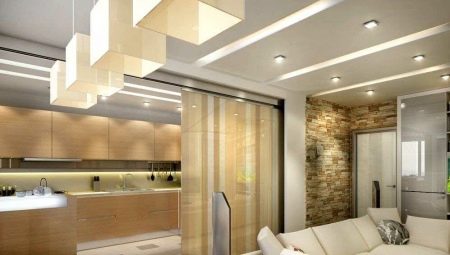
Competent zoning of space is a whole art, but you can master it. If you want to rationally plan, equip every meter of the apartment with intelligence and high aesthetic requirements, you cannot do without these skills. And if the apartment is not very large, but you want to accommodate a recreation area, a media zone, a library, a dining room, a study, and even a children's corner on its territory, you will have to resort to zoning secrets.
What is it for?
Living room zoning always pursues certain goals. Most often, the owners want divide one room into different functional areas: this is how a sleeping zone can appear in the living room, for example. Zoning in some cases helps to visually enlarge the room. If the room is quite large, then it can be made more comfortable and organized.
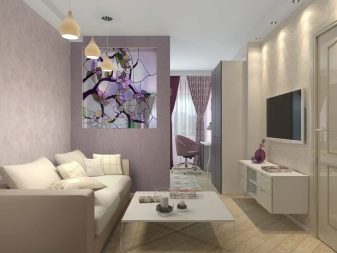
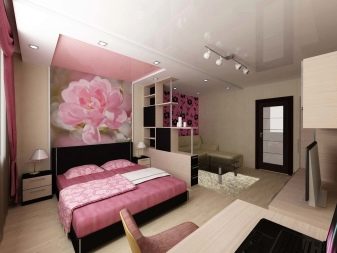
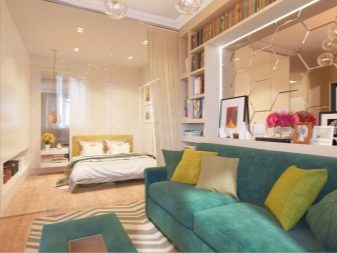
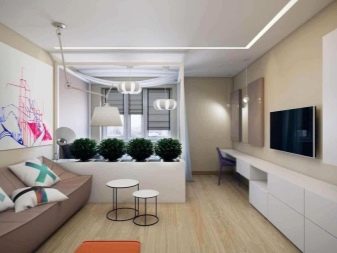
Zoning can be done for two polar reasons, such as:
- a small apartment in which you need to equip several functional sectors;
- the apartment is quite spacious so that it does not seem empty and disorganized; several zones are arranged on a large footage.
It is believed that three zones in one room is the maximum, a larger number is already more difficult to organize. The effect of overcrowding and clutter can occur even over a relatively large area.

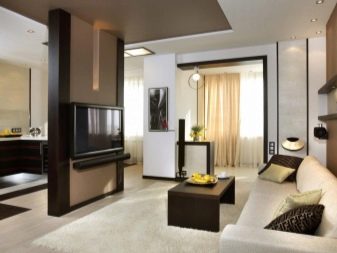


What zones can you highlight?
The classic division is a relaxation area and a dining (dining) area. More and more often, the owners perceive the kitchen only as a place for cooking and do not suit a full-fledged dining area there. They can only leave the bar counter or arrange a countertop from the windowsill.But the whole family cannot dine in such cramped conditions.
And the living room often turns out to be an empty room, since the days of sections and large headsets are gone. And in the traditional living room there is a place to organize a dining area.
In addition, the following zones can be allocated in the living room.
- Rest area. This is a sofa plus armchairs (if desired) and a small table.

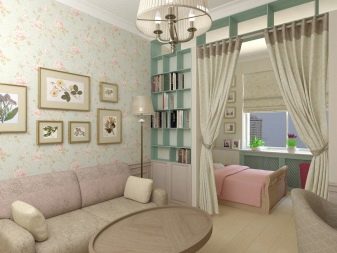
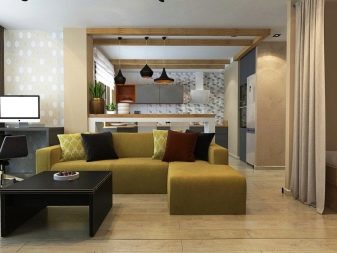
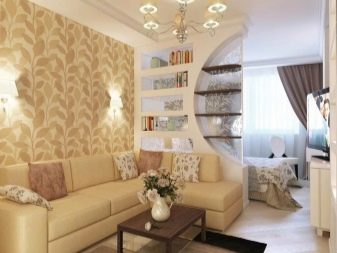
- Mediazona. A space in which the TV plays the main role (there can also be a home theater, a stereo system, and so on).



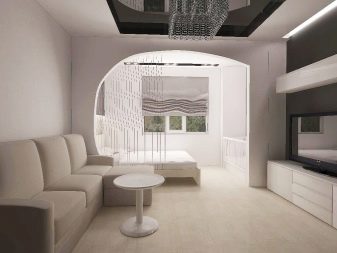
- Study - a corner with a full work desk, shelves, local lighting, and so on.
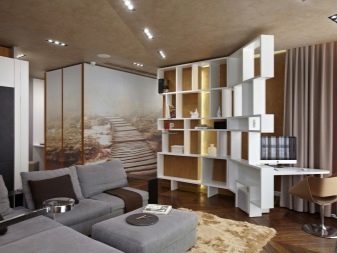
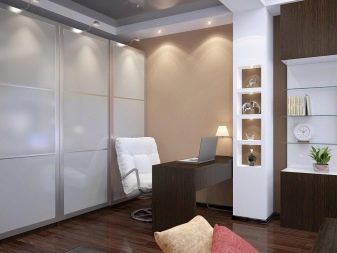
- Library - if it is rather big, and you want to highlight this sector.
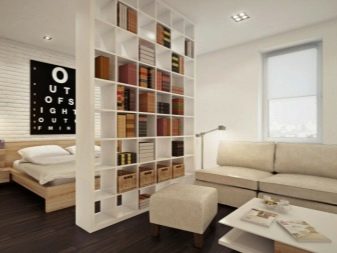
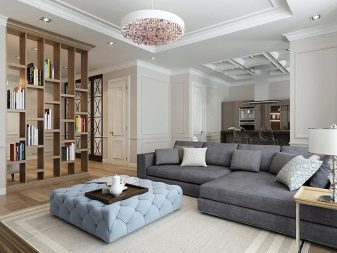
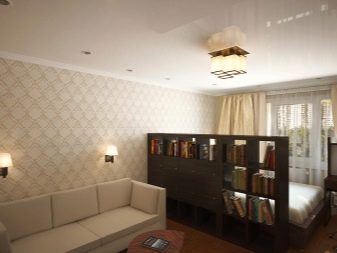
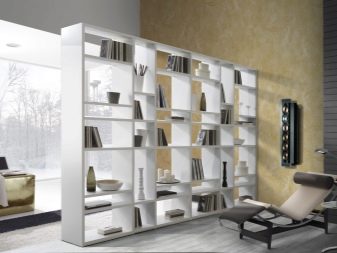
- Bedroom. This allocation is appropriate in a one-room apartment or in a "kopeck piece" where the second room is given over to the nursery.
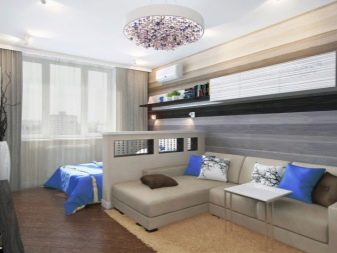
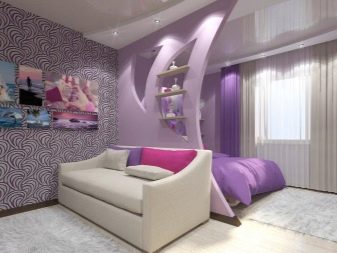

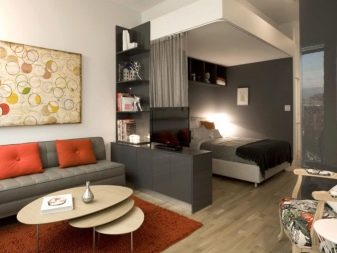
- Children's Corner - if the apartment does not yet have a full-fledged children's room, the child sleeps in the parents' bedroom and so on.
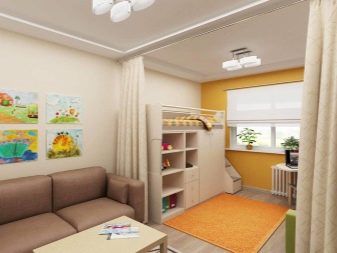
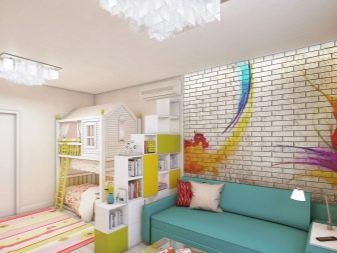
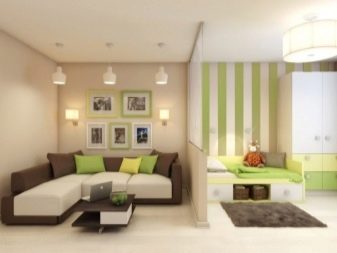
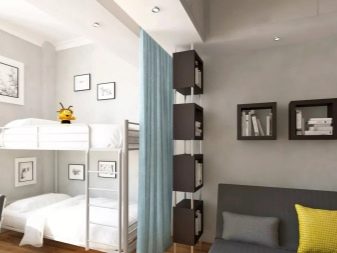
These are the most common cases of division, usually a room is divided into 2-3 zones. Zoning can be clear and strict, but it can also be blurry. If you have a bedroom in the hall, the zoning should be strict, but the media zone and the recreation sector differ slightly.
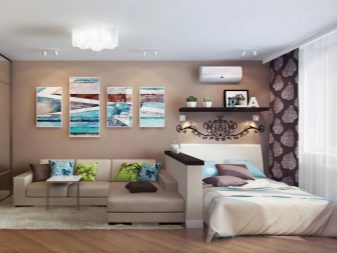
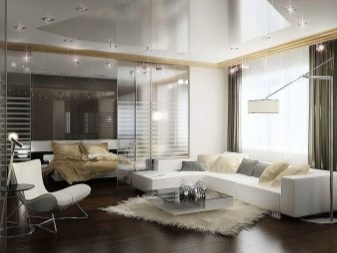

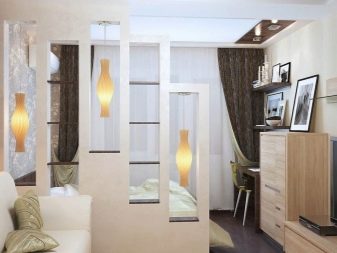
How and how to divide the space?
You can zone a room in different ways. There are cases when the division actually forms two from one room, but this is risky - the area is "eaten up", unless the radical division is played up with the right choice of materials, textures, shades. Let's take a look at the most common and interesting sharing tools.
Partitions
These can be plasterboard structures and the so-called sliding walls. The latter option is optimal if you need to separate the main part of the living room from the sleeping area, that is, the personal area in this case is hidden from prying eyes.
Usually in such a situation is used frosted glass, less often - plastic. Structures are made to order. Dark colors and expressive edging are not needed for sliding structures - a standard frosted glass is enough, it is possible with an unobtrusive pattern.
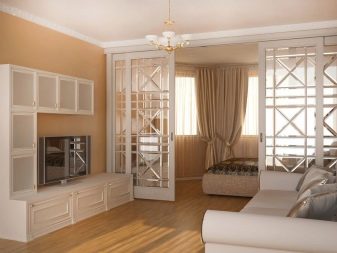
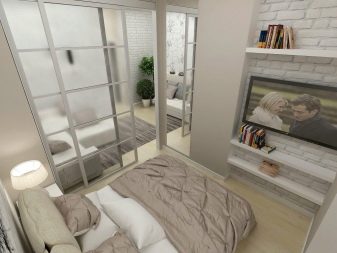
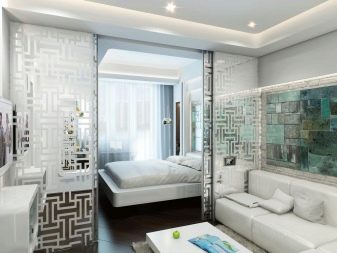
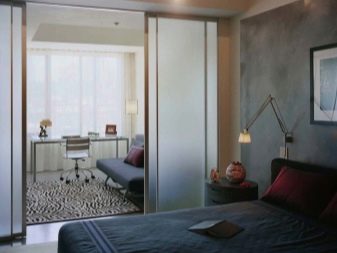
Plasterboard partitions convenient in that they change the layout of the room. You decide how thick they will be, how wide they will be, whether there will be niches or shelves in them. Often, a plasterboard partition on the one hand is formed like a library, on the other it is a wall for a sleeping or dining area. Such zoning can be considered radical, since in fact you are dividing the room into two parts, forming two small rooms in one space.
And here one cannot be mistaken with the light if there is only one window in the living room. Usually the central area with a sofa, a table, and a TV is darkened. In this case, you need to think over the lighting correctly, since if there is only one central chandelier, it will clearly not be enough.
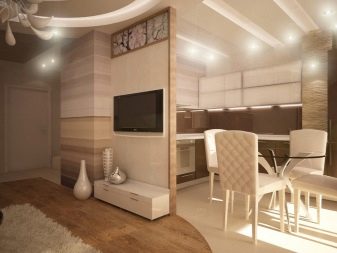
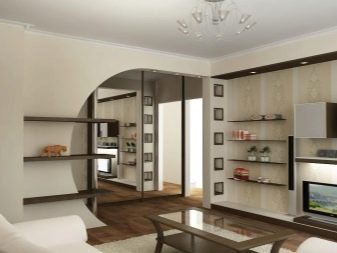
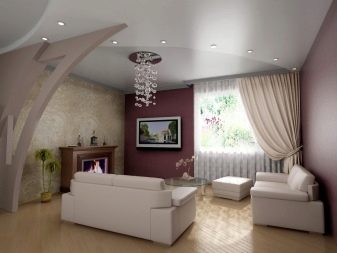
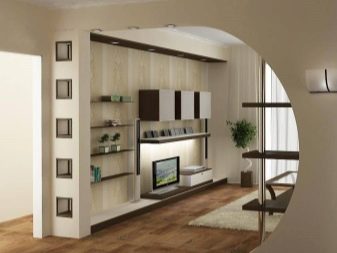
Finishing
This is a less expressive way of dividing, since no walls and partitions are erected, softer instruments are used. Wallpaper and flooring help to visually separate one part of the room from another. The room is not cluttered with massive structures, which is very convenient if the living room area is small.
Zones are separated where the wallpaper changes. For example, in the dining area, they are darker than in the rest of the space. The floor zones the room usually not by changing the coverage, but by the arrangement of the podium.
He raises one of the sectors of the room, which noticeably distinguishes it. You can do the same with the ceiling, but today such divisions are not the most relevant, since the fashion for complex ceilings is gradually disappearing.

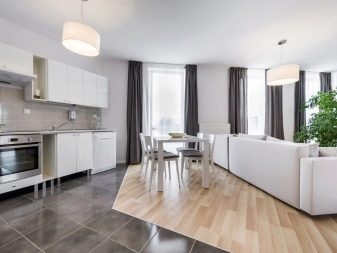
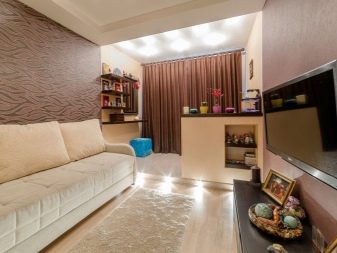
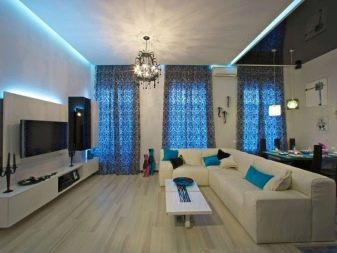
Furniture
If the living room is combined with the kitchen (and this option should also be taken into account), then most often there are two spaces shares bar counter. The seating area is separated by a sofa with its back turned towards the other part of the hall. Shelves can be perceived as a kind of partitions.They can separate the sofa area from the mini-cabinet or the main part of the living room from the children's corner.
But to put a closet in the middle of the room, as it was customary to do back in Soviet times, today almost never occurs to anyone. Instead, modern glass partitions become dividers.

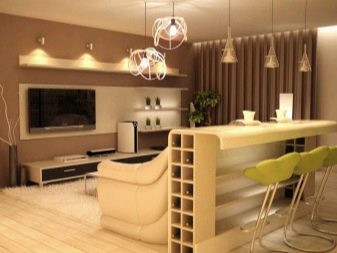
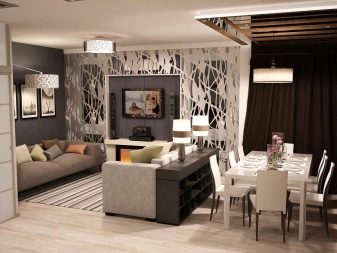

Lighting
Usually this is not the only zone in the space, but an additional one. In the recreation area, central lighting is often provided - large chandelier. But in the dining room sector there may be low bar lamps or wall sconces. Often in the sleeping area there are floor lamps or two table lamps on the sides of the bed. Spot lighting is appropriate in any of the zones, if the owners like such lighting and will be in demand.
Do not forget that the fashion of creating hygge in your home has popularized candles again. And now, instead of artificial fireplaces, many people install wooden boxes in the living room, and inside there are many large candles that can be lit in the evenings to create special comfort.


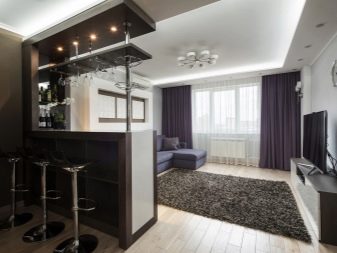
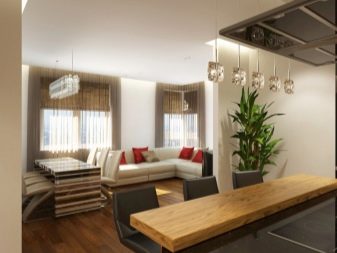
Columns and beams
Such zoning will be appropriate only if the living room space is initially rather big, and if the room design style does not conflict with such small architectural structures. Columns are commonly found in the huge living rooms of country houses., and the ceiling beams look more appropriate in a room with a large footage, decorated in one of the varieties of country style, for example.
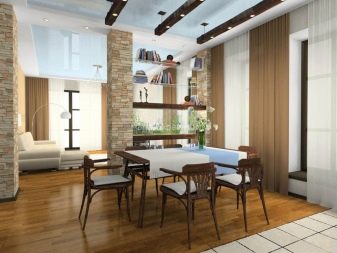

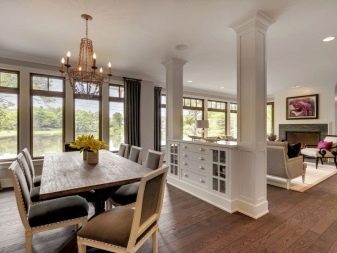
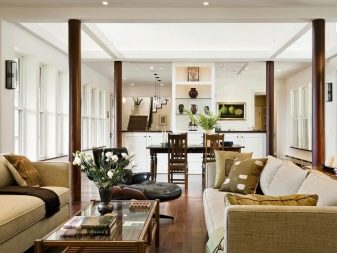
Podium
But the podium can be arranged even in a small living room. And if you equip it with drawers, you will organize additional storage space in the apartment. A pull-out bed is even built into it, which is very convenient if you are zoning a one-room apartment. The podium will not reduce the area of the room, but high ceilings are a prerequisite for its organization.
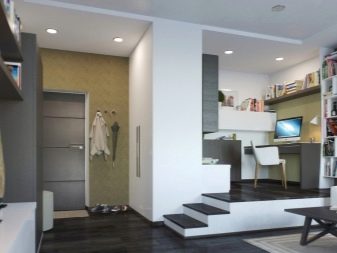
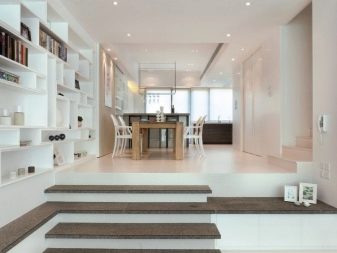
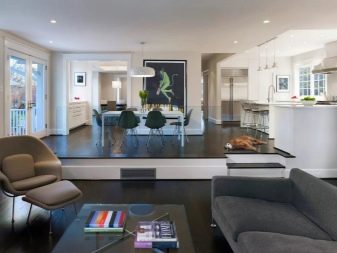
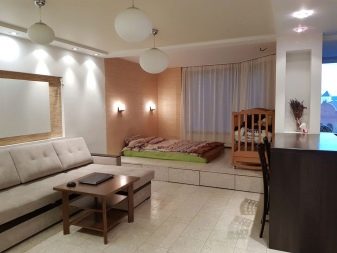
Curtains
Such zoning is perhaps the most budgetary option. Filament curtains are predominantly chosen, which look more decorative and less intrusive. There are very beautiful curtains with beads that undoubtedly decorate the space. In this way, you can select a sleeping area, a children's corner, a study or a mini-workshop of a needlewoman.

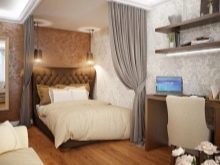
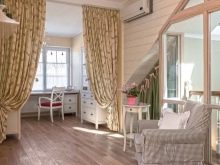
Design techniques
Division of space, changes in planning require a rational approach. Take advantage of the design tips because the result of zoning should be not only attractive in appearance, but also convincing in its functionality.
- Wall shelves - do not be afraid of this element, it does not clutter up the space if you do not litter it yourself. It is a valuable addition to furniture that can be highly decorative. Sometimes even the wall shelves themselves function as zoners and visually separate the interior.


- Do not be afraid to use transformable furniture: small becomes big - this is the main principle of such designs. A small coffee table in front of the TV, if necessary, turns into a full dining table. A pull-out bed hidden in a podium or closet would also be a good idea.
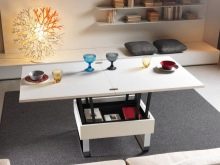
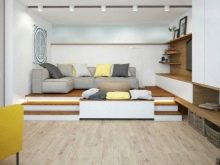
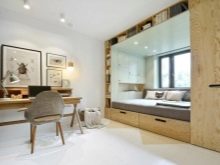
- If the living room is the only room in the apartment, and the child has already grown up, get him a loft bed, on the ground floor which can accommodate a work desk. You have to save space and this method looks very logical.
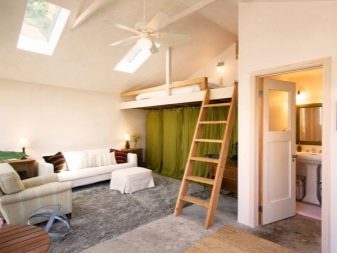
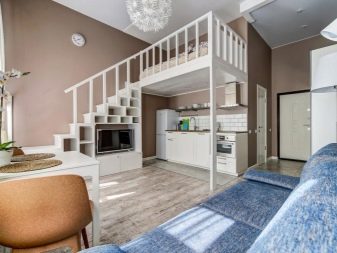
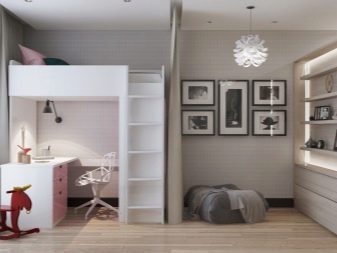
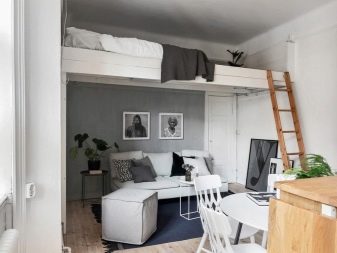
- Very often the window, or rather the window sill, remains intact. No furniture is attached to it, considering it inconvenient. But even the window sill itself can be turned into a desk. Do not be afraid to put a dining or work table by the window, you will see for yourself how much useful space is freed up.
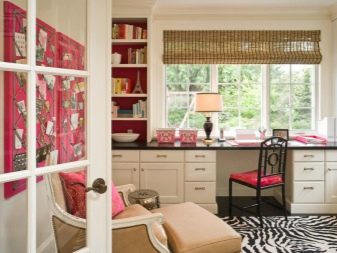
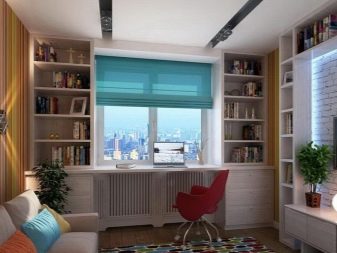
- When arranging a sleeping area behind a partition in the living room, do not hang a mirror in front of the bed (or do not put a wardrobe with a mirrored wall), since the reflection of the bed will be visible to everyone in the living room, which is not very comfortable, of course.
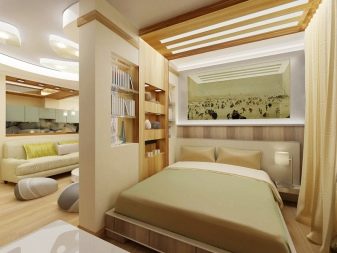
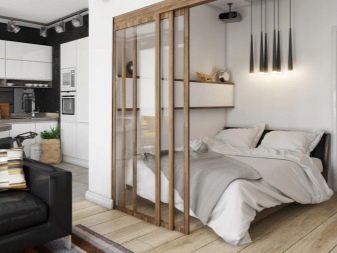
- Think about what you can definitely refuse in the living room. For example, there is a cabinet with zero functionality under the TV. Even if it fits into the design, then nothing changes without it, only there is more space. Look for more rational media zone design options. And the curbstone, by the way, can be taken out into the hallway, soft comfortable pillows can be laid on it, and the useless thing will become a beautiful bench, inside which you can store shoes and so on.

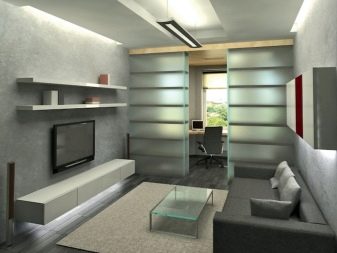
Successful examples
A beautiful living room is a perfectly organized space that is not overloaded, does not conflict stylistically, in color, and is comfortable for its owners. This collection contains 10 striking examples of living room zoning.
A soft and unobtrusive option for arranging a living room, which also serves as a bedroom... A good selection of colors, an interestingly made partition, the absence of unnecessary elements. And such repairs will not be expensive.
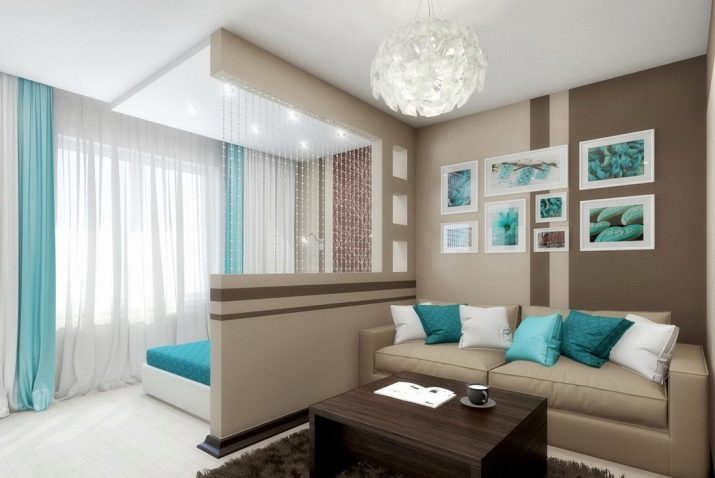
No less original option, in which a fabric curtain on a small wooden partition will be a zoner. A study is conveniently hidden behind it. A good color scheme successfully plays on not the largest footage of the room.
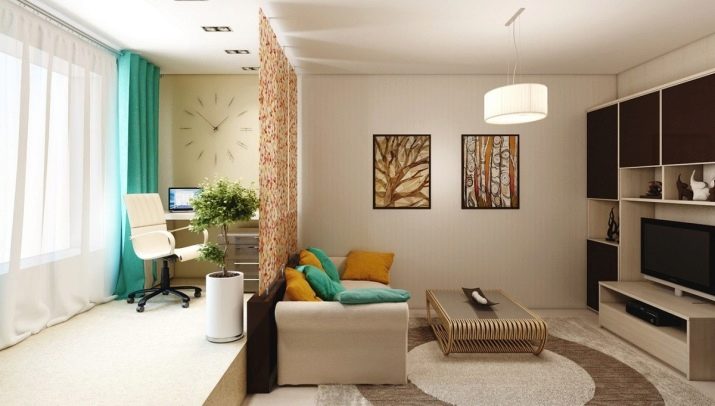
And this is a large living room in which the owners decided to organize three zones at once. An example of the fact that you do not need to be afraid to move furniture away from the walls (sofa), and how well the shelves with books are shared in the living room. The dining area allows people who are there not to be distracted by what is happening elsewhere in the room.
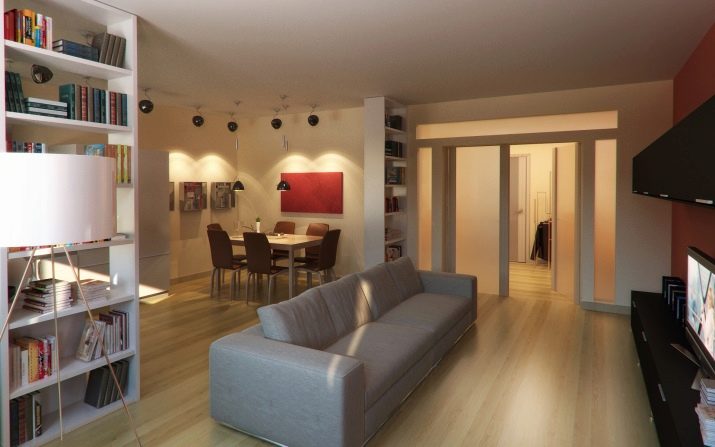
A large living room in which the owners arranged a nursery. And this is an interesting option if the apartment has only one room or there is a second one, but the parent's bedroom is located there. This option can be called successful if the kitchen is spacious and the main receptions are held there. In such a situation, a full-fledged living room is not needed, since the option in the picture is optimal.

And this is a variant of the kitchen-living room, which is zoned with cotton curtains, different designs of the ceiling and floor. You can't tell right away that the initial footage is not very large.
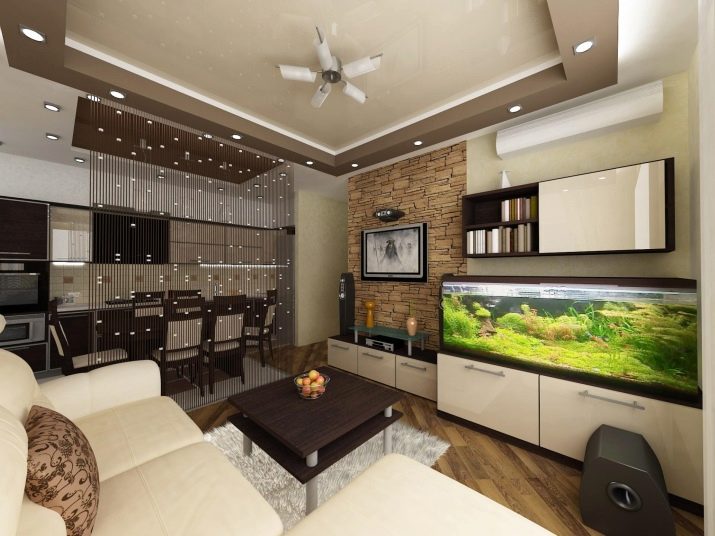
A good option for an L-shaped room or for a room where such a partition-wall is arranged. The sleeping area is hidden behind curtains. Everything here is laconic and just perfect in color.

In this example, there are several dividers at once: a sofa, wallpaper, and a ceiling beam. The dining area is combined with a children's corner. And this is really convenient, because a large table is used not only for meals, but also for children's games.
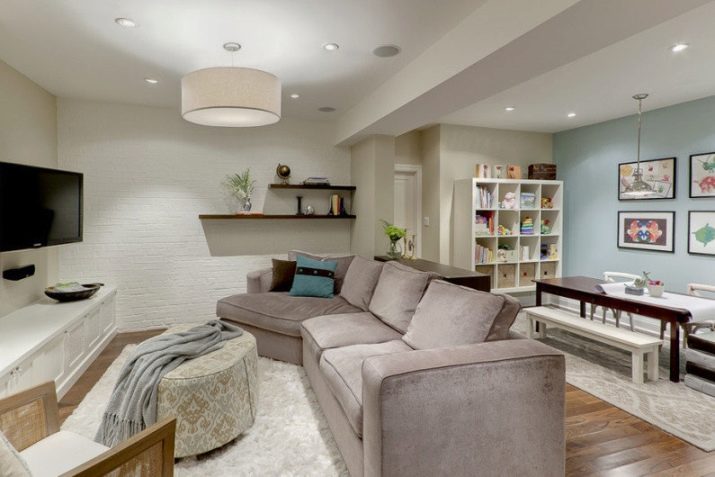
Very delicate zoning: a small partition and a ceiling beam subtly change the layout of the room. One living room accommodates a resting place with a media zone, a dining room and a study.

And this is a good option for hiding a sleeping place (in the form of a sofa) and a toilet corner for a woman behind a partition. Soft pastel colors, pleasant finishes are a good solution for a long narrow living room.

Podium zoning. It is very roomy inside, it houses a work area, and a pull-out bed. The lighting system is different for the two zones.
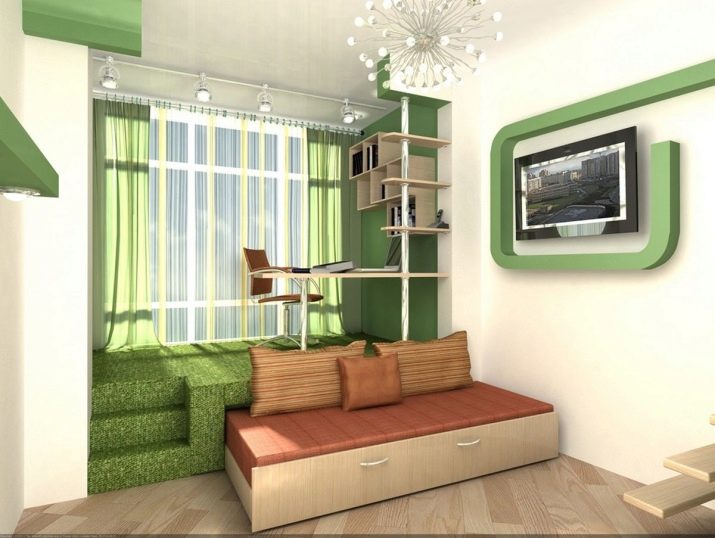
It's obvious that You can find many quality options for dividing space. And this is all for standard apartments, but if we are talking about spacious houses, there are much more opportunities there.
For the secrets of interior design when zoning a living room, see below.








